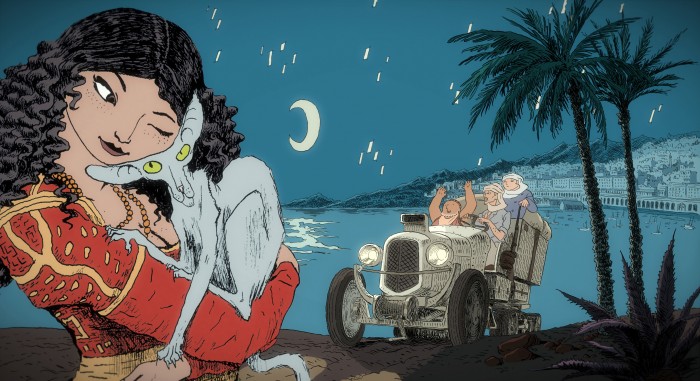US Premiere of The Rabbi’s Cat
17 Apr2012
French film “Le Chat du Rabbin†(“The Rabbi’s Cat”) premiers at the Museum of Modern Art in New York
By Michael Brick

Last summer, crowds of enthusiastic French theatergoers welcomed the wide release of Le Chat du Rabbin, (“The Rabbi’s Cat,â€) an adaptation of the exceptionally popular graphic novel by Joann Sfar, who also directed the film. On March 25th, the film had its United States premier at the Museum of Modern Art in New York, in conjunction with The Film Society of Lincoln Center, in the program New Directors/New Films 2012.
As an extended evaluation of Judaism’s place within an ever more open and cosmopolitan society, Le Chat du Rabbin begins by explaining that traditionally, Jews are not very fond of dogs. Dogs bark, bite, and chase after you. Since Jews have been barked at, bitten, and chased out of so many places, it makes sense that they should prefer cats. The specific cat in question (voiced by François Morel, an actor well-known, above all, for his work in French television) belongs to Rabbi Abraham Sfar (voiced by Maurice Bénichou, whom American audiences might recognize as Dominique Bretodeau, the man whose box of treasures is discovered by the title character in “Amélieâ€), a man in his 50s living in Algiers sometime during the 1920s.  The cat does not have a name, and is known around the neighborhood simply as “The Rabbi’s Cat.â€Â The cat’s principal source and object of affection is the rabbi’s daughter, Zlabiya, (“My mistress,†[Maitresse] the cat calls her, a word he caresses with delightful lasciviousness) whose name, we are told, refers to a kind of honeyed pastry. The cat miraculously gains the ability to speak after devouring the family parrot (an allegation he subsequently denies). Soon after, the rabbi suspects the cat has become a bad influence on his daughter when he finds the two together reading Stendhal’s The Red and the Black (“This is political propaganda, isn’t it?†“No, it’s a love story.†“EVEN WORSE!â€). He forbids them to spend any more time with each other. Desperate, the cat asks if he might be allowed to stay with Zlabiya if he becomes a good Jew and has his Bar Mitzvah. The rabbi is skeptical, but ultimately entertains the proposal. Thereafter, having his Bar Mitzvah becomes the cat’s Idéfix (to reference another famous French cartoon pet), not because he is in any way a true believer (he finds most religious doctrine patently absurd), but because a Bar Mitzvah represents his ticket back to his beloved mistress.
The theme underlying the various twists and turns of the ensuing narrative is Joann Sfar’s ongoing meditation on his own Jewish identity. The son of a Sephardic father and an Ashkenazi mother, Sfar identifies as a “Berber Jew†while also making clear in numerous interviews that he is not a believer. “[As for] me,†he says, “who received a religious education but who is not a believer, I have criticisms to make about [Judaism], but they’re affectionate. I have no desire to spit in the face of the religious person. To the contrary, it’s true that sometimes I prefer Voltaire to the Bible, and maybe my cat does as well… but there is a sincere love for the populations involved.†(source)

Although it is clear that many of the events that take place over the course of “Le Chat du Rabbin†are in fact taken from stories passed down to Sfar from his father’s side of the family, it is not clear whether the character of the Rabbi Sfar is actually based on a distant relative. In any case, despite his various bumblings and knee-jerk reactions, Rabbi Sfar is a decidedly sympathetic character who clearly cares very deeply about his community, his daughter, and even his mischievous, blaspheming cat. He is set up as a model of good religiosity in contrast to several models of bad religiosity, which include an elder Rabbi who insists they ought to drown the cat at once.
(Spoiler Alert)
Two essential elements of Rabbi Sfar’s ostensible appeal as a character and as a model of religiosity are his repeatedly demonstrated friendliness to people of other cultures and persuasions as well as his willingness to compromise on matters of established religious doctrine and practice. For instance, when he fails to persuade his cat that the scientific community might be mistaken, and that the world might indeed be only 5700 years old, the Rabbi adopts a different approach, suggesting that perhaps years have no meaning if human beings are not keeping track of them, and that 5700 years might be the age of the oldest calendar. The cat much prefers this interpretation. When Rabbi Sfar takes in an Ashkenazi painter seeking refuge from pogroms in Russia, he defends his guest’s portraits against critics who condemn them as violations of the second commandment. While making a pilgrimage to the tomb of a renowned ancestor, Rabbi Sfar meets an imam named Mohammed Sfar who claims the same ancestor. The two become fast friends and promptly pray together, the one facing Jerusalem, the other facing Mecca. When the rabbi, the painter, and the imam decide to travel across Africa together, Rabbi Sfar is happy to learn a new way of playing drums from a clan of Touareg nomads. Along the way, the painter falls in love with a black barmaid, who asks to be converted to Judaism so that she might marry the painter and share her husband’s religion. Rabbi Sfar initially hesitates, saying that it takes years of study to become a Jew. He quickly gives in, however, after the painter points out that his village in Russia is full of Jews who have never studied anything. Perhaps the single most amusing moment of the film is when Rabbi Sfar shoots a crocodile and then happily sings blessings over the very un-kosher carcass as it roasts on a spit.  Much more disturbing is the dialogue that transpires when the band of travelers is forced to impose upon the hospitality of a group of Bedouins whom the imam describes as “fanatics.â€Â The Bedouins demand to know whether the rabbi recognizes Islam as superior to Judaism. “Oh, yes, uh… certainly,†says the rabbi. When asked why, in that case, he doesn’t simply convert, the rabbi responds, “I will keep my religion because I already know all the prayers in Hebrew, and if I had to relearn them differently, it would be too much work for me.â€Â Thus the pluralism and ecumenism manifested by Rabbi Sfar (and implicitly advocated by Joann Sfar) verges on what amounts to a very weak commitment to Judaism.

Indeed, it is almost certainly fair to say that Joann Sfar, as a self-identified “Berber Jew,†has a far stronger attachment to the “Berber†than to the “Jew.†As he himself has explained it, Sfar’s main objective in writing and directing “Le Chat du Rabbin†is to cultivate and appeal to a common Berber or Maghrebien identity that transcends religious divisions. He admits to having intentionally drawn Jewish characters that have “the most Arab appearance possible.†He has repeated in several interviews that of all the feedback he has received, he was most pleased by the response of two Arab girls who told him that they liked the film “because it showed us that Jewish families are just as ridiculous as Arab families.â€
Sfar’s cultural project has significant political ramifications. As a respected Jewish figure in French popular culture, Sfar has conspicuously refused to comment on events and developments in Israel, saying, “I claim the right of Jews and Muslims to be neither Israelis nor Palestinians, but to call ourselves Maghrebien or Berber.†In a country where discussions of religious pluralism are inseparable from discussions of national identity, assimilation, and the legacy of imperialism, Sfar’s claim strikes a sharp nerve. It necessarily raises the question of why Joann Sfar—who was born and raised in France, who is only of half Maghrebien descent, and who has readily found both professional success and mainstream acceptance—wouldn’t rather claim the right of Jews and Arab Muslims to call themselves French.
As it happens, the least redeemable figures to appear in “Le Chat du Rabbin†are the representatives of French and Belgian colonialism. Early on in the film, Rabbi Sfar is denied service at an elegant French café, (a café that serves neither Arabs nor Jews) until he invites his cousin to join him there with his pet lion. In order to continue to lead services in Hebrew among Jews who speak Arabic, Rabbi Sfar is forced to take a French language proficiency test. The cat offers to help him cheat, saying, “There is no need to respect the laws of crazy people.†When the rabbi, the painter, and the imam travel through the Belgian Congo, they encounter a thinly veiled parody of Tintin, an insufferably condescending young man who “talks all the time†and who “listens to nothing.†The worst, however, is a French artist who comes across the Ashkenazi painter as he is sketching a portrait of his fiancé. The Frenchman grabs the black barmaid roughly by the arm, slaps a pencil to her face, and says, “The key to the negro face is the sloping forehead,†gesturing to a manual with diagrams that compare a black African face to that of an ape. The painter responds by punching the Frenchman in the nose, later explaining, “In my country, they draw pictures like that of Jews.â€
This constitutes what is probably the single most powerful and revealing assertion of Jewish identity in the entire film. As could be said of “Le Chat du Rabbin†as a whole, it illustrates how a man as secular and westernized as Joann Sfar might continue to be inspired by his Jewish heritage to identify with a once subjugated and now marginalized minority population.  This, as much as anything, seems an admirable role for Jewish identity to play in today’s world.
- In: Exhibition Reviews
- Tags: Europe, Film




